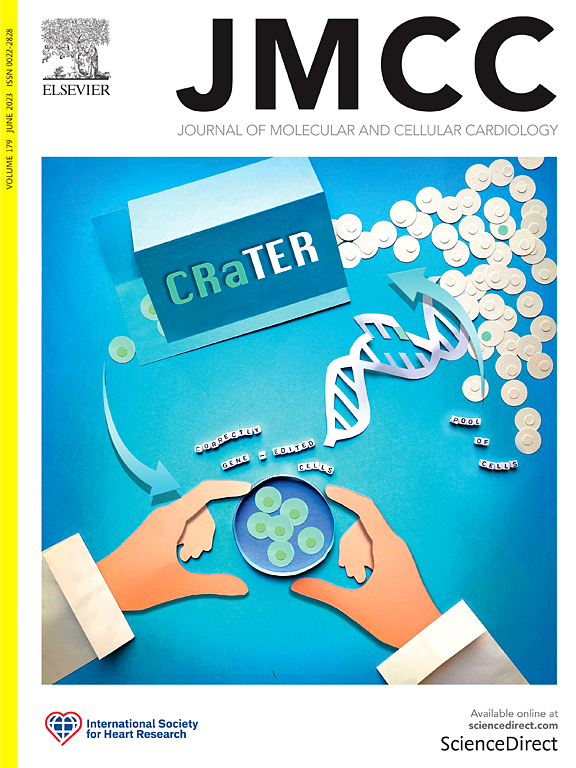Modelling diabetes-associated metabolic stress in human multicellular cardiac microtissues
IF 4.7
2区 医学
Q1 CARDIAC & CARDIOVASCULAR SYSTEMS
引用次数: 0
Abstract
Type 2 diabetes is a global health crisis, closely associated with an increased risk of heart failure due to the development of diabetic cardiomyopathy. Progress in understanding the underlying mechanisms and identifying effective treatments has been limited by the lack of robust preclinical models that accurately mimic human cardiac physiology. Human induced pluripotent stem cells (iPSCs) offer the unique ability to generate large quantities of both cardiomyocytes and non-myocytes, enabling the development of advanced models for cardiovascular research. In this study, we present engineered 3D multicellular cardiac microtissues, comprising human iPSC-derived cardiomyocytes, endothelial cells, autonomic neurons, and cardiac fibroblasts, designed to provide a more physiologically relevant platform for investigating the effects of diabetogenic conditions on human heart tissue. Under diabetogenic conditions, these multicellular cardiac microtissues exhibited reduced viability, fibrotic marker expression, and prolonged systolic and diastolic phases, closely mirroring the contractile dysfunction observed in late-stage diabetic cardiomyopathy, outcomes not replicated in traditional 2D culture of cardiomyocytes or cardiomyocyte-only microtissues. Metformin treatment prevented the manifestation of diastolic dysfunction induced by diabetogenic conditions, demonstrating the utility of multicellular cardiac microtissues for drug assessment. Our findings emphasize the critical role of non-myocytes in the progression of cardiac dysfunction induced by hyperglycaemia and hyperlipidaemia, underscoring their importance in disease modelling. These iPSC-derived multicellular cardiac microtissues represent a significant advancement in preclinical models for diabetic cardiomyopathy, providing a more accurate platform for mechanistic studies and drug discovery.

模拟人类多细胞心脏微组织中糖尿病相关的代谢应激。
2型糖尿病是一种全球性的健康危机,与糖尿病性心肌病引起的心力衰竭风险增加密切相关。由于缺乏准确模拟人类心脏生理学的强大临床前模型,在理解潜在机制和确定有效治疗方面的进展受到限制。人类诱导多能干细胞(iPSCs)提供了产生大量心肌细胞和非心肌细胞的独特能力,使心血管研究的先进模型得以发展。在这项研究中,我们提出了工程化的3D多细胞心脏微组织,包括人类ipsc衍生的心肌细胞、内皮细胞、自主神经元和心脏成纤维细胞,旨在为研究糖尿病对人类心脏组织的影响提供一个生理学上更相关的平台。在糖尿病发病条件下,这些多细胞心脏微组织表现出活力降低、纤维化标志物表达、收缩期和舒张期延长,与晚期糖尿病心肌病中观察到的收缩功能障碍密切相关,这些结果在传统的二维心肌细胞培养或仅心肌细胞的微组织中无法复制。二甲双胍治疗可防止糖尿病引起的舒张功能障碍,证明了多细胞心脏微组织在药物评估中的实用性。我们的研究结果强调了非肌细胞在高血糖和高脂血症引起的心功能障碍进展中的关键作用,强调了它们在疾病建模中的重要性。这些ipsc衍生的多细胞心脏微组织代表了糖尿病心肌病临床前模型的重大进展,为机制研究和药物发现提供了更准确的平台。
本文章由计算机程序翻译,如有差异,请以英文原文为准。
求助全文
约1分钟内获得全文
求助全文
来源期刊
CiteScore
10.70
自引率
0.00%
发文量
171
审稿时长
42 days
期刊介绍:
The Journal of Molecular and Cellular Cardiology publishes work advancing knowledge of the mechanisms responsible for both normal and diseased cardiovascular function. To this end papers are published in all relevant areas. These include (but are not limited to): structural biology; genetics; proteomics; morphology; stem cells; molecular biology; metabolism; biophysics; bioengineering; computational modeling and systems analysis; electrophysiology; pharmacology and physiology. Papers are encouraged with both basic and translational approaches. The journal is directed not only to basic scientists but also to clinical cardiologists who wish to follow the rapidly advancing frontiers of basic knowledge of the heart and circulation.

 求助内容:
求助内容: 应助结果提醒方式:
应助结果提醒方式:


